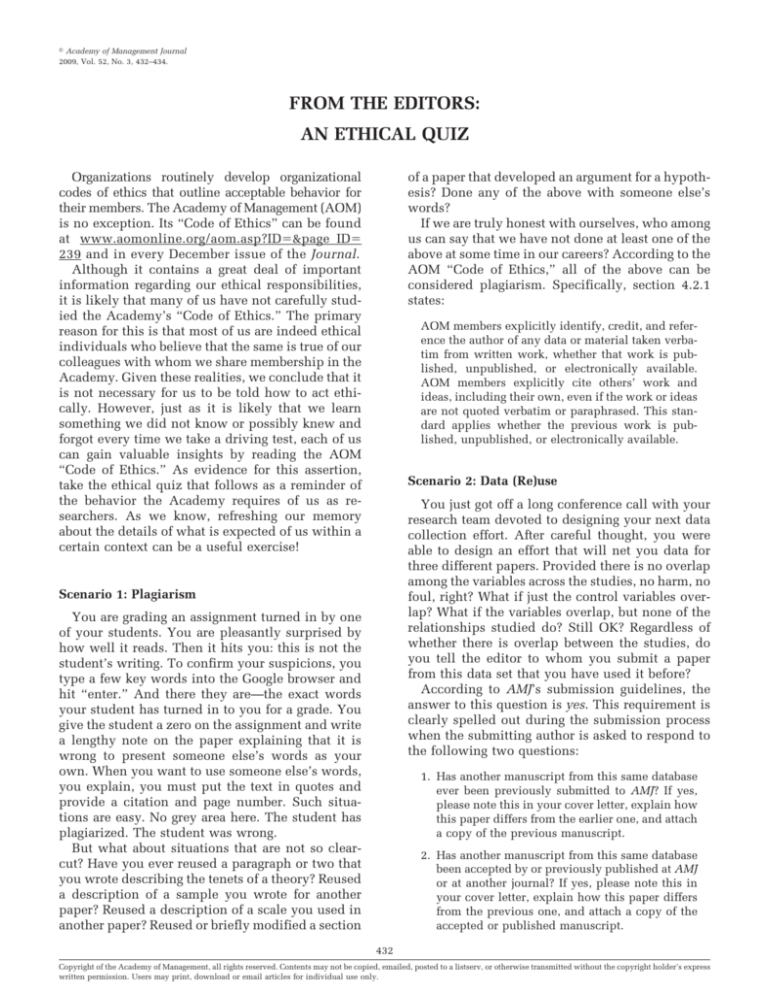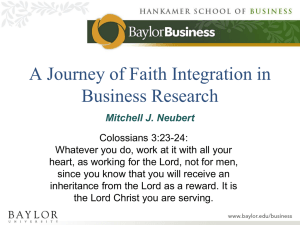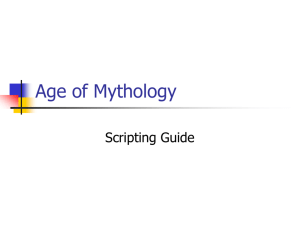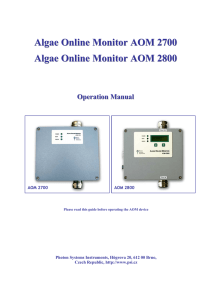
娀 Academy of Management Journal
2009, Vol. 52, No. 3, 432–434.
FROM THE EDITORS:
AN ETHICAL QUIZ
Organizations routinely develop organizational
codes of ethics that outline acceptable behavior for
their members. The Academy of Management (AOM)
is no exception. Its “Code of Ethics” can be found
at www.aomonline.org/aom.asp?ID⫽&page_ID⫽
239 and in every December issue of the Journal.
Although it contains a great deal of important
information regarding our ethical responsibilities,
it is likely that many of us have not carefully studied the Academy’s “Code of Ethics.” The primary
reason for this is that most of us are indeed ethical
individuals who believe that the same is true of our
colleagues with whom we share membership in the
Academy. Given these realities, we conclude that it
is not necessary for us to be told how to act ethically. However, just as it is likely that we learn
something we did not know or possibly knew and
forgot every time we take a driving test, each of us
can gain valuable insights by reading the AOM
“Code of Ethics.” As evidence for this assertion,
take the ethical quiz that follows as a reminder of
the behavior the Academy requires of us as researchers. As we know, refreshing our memory
about the details of what is expected of us within a
certain context can be a useful exercise!
of a paper that developed an argument for a hypothesis? Done any of the above with someone else’s
words?
If we are truly honest with ourselves, who among
us can say that we have not done at least one of the
above at some time in our careers? According to the
AOM “Code of Ethics,” all of the above can be
considered plagiarism. Specifically, section 4.2.1
states:
AOM members explicitly identify, credit, and reference the author of any data or material taken verbatim from written work, whether that work is published, unpublished, or electronically available.
AOM members explicitly cite others’ work and
ideas, including their own, even if the work or ideas
are not quoted verbatim or paraphrased. This standard applies whether the previous work is published, unpublished, or electronically available.
Scenario 2: Data (Re)use
You just got off a long conference call with your
research team devoted to designing your next data
collection effort. After careful thought, you were
able to design an effort that will net you data for
three different papers. Provided there is no overlap
among the variables across the studies, no harm, no
foul, right? What if just the control variables overlap? What if the variables overlap, but none of the
relationships studied do? Still OK? Regardless of
whether there is overlap between the studies, do
you tell the editor to whom you submit a paper
from this data set that you have used it before?
According to AMJ’s submission guidelines, the
answer to this question is yes. This requirement is
clearly spelled out during the submission process
when the submitting author is asked to respond to
the following two questions:
Scenario 1: Plagiarism
You are grading an assignment turned in by one
of your students. You are pleasantly surprised by
how well it reads. Then it hits you: this is not the
student’s writing. To confirm your suspicions, you
type a few key words into the Google browser and
hit “enter.” And there they are—the exact words
your student has turned in to you for a grade. You
give the student a zero on the assignment and write
a lengthy note on the paper explaining that it is
wrong to present someone else’s words as your
own. When you want to use someone else’s words,
you explain, you must put the text in quotes and
provide a citation and page number. Such situations are easy. No grey area here. The student has
plagiarized. The student was wrong.
But what about situations that are not so clearcut? Have you ever reused a paragraph or two that
you wrote describing the tenets of a theory? Reused
a description of a sample you wrote for another
paper? Reused a description of a scale you used in
another paper? Reused or briefly modified a section
1. Has another manuscript from this same database
ever been previously submitted to AMJ? If yes,
please note this in your cover letter, explain how
this paper differs from the earlier one, and attach
a copy of the previous manuscript.
2. Has another manuscript from this same database
been accepted by or previously published at AMJ
or at another journal? If yes, please note this in
your cover letter, explain how this paper differs
from the previous one, and attach a copy of the
accepted or published manuscript.
432
Copyright of the Academy of Management, all rights reserved. Contents may not be copied, emailed, posted to a listserv, or otherwise transmitted without the copyright holder’s express
written permission. Users may print, download or email articles for individual use only.
2009
The “Code of Ethics” also speaks to this issue, in
section 4.2.3.5:
When AOM members publish data or findings that
overlap with work they have previously published
elsewhere, they cite these publications. AOM members must also send the prior publication or “in
press” work to the AOM journal editor to whom
they are submitting their work.
Scenario 3: Institutional Review Board (IRB)
We all have heard of the horror stories of Tuskegee, Milgram, and Mengele. Obviously, our research would never incorporate such egregious violations of human rights. However, has your
research ever incorporated deception—such as a
cover story to throw the respondents off the track of
the true purpose of your study? Have any of us ever
used a subject who is less than 18 years of age?
Have we ever been involved in a research project
that spanned multiple schools and only had IRB
approval from one school? Used secondary or deidentified data without IRB approval? Received IRB
permission to conduct a study but made changes to
the procedures outlined in the protocol during implementation of the study without first getting permission from the IRB to do so? Conducted a study
without filing an IRB protocol? All of these actions
can be considered violations of the human subjects’
standards at some institutions.
What about research conducted at institutions
that do not have IRBs or do not require research
efforts be approved? At a minimum, scholars in this
situation must adhere to the components of the
AOM “Code of Ethics” that speak to the rights of
subjects:
Participants. It is the duty of Academy members to
preserve and protect the privacy, dignity, wellbeing, and freedom of research participants. (“Professional Principles,” item 2.)
Informed Consent. When AOM members conduct
research, including on behalf of the AOM or its
divisions, they obtain the informed consent of the
individual or individuals, using language that is
reasonably understandable to that person or persons. Written or oral consent, permission, and assent is documented appropriately. (1.7.)
When deletion of personal identifiers is not feasible,
AOM members take reasonable steps to determine
that the appropriate consent of personally identifiable individuals has been obtained before they
transfer such data to others or review such data
collected by others. (2.4.2.)
Kacmar
433
Scenario 4: Coauthors
We’ve all been there—worked on a project with a
coauthor who did not hold up his/her end of the
bargain. What did you do? Move him or her down
in order of authorship? Bump him or her off the
paper? Did you undertake either of these actions
without first discussing it with the coauthor? Perhaps you gave the nonparticipating coauthor a
deadline contingent on continued authorship that
you knew she/he could not meet. How about adding a coauthor without getting the permission of
those already on the paper? Have you submitted a
paper to a journal or conference without all of the
authors being aware of your actions? Or perhaps
you have experienced one or more of these
situations.
Just as there are ethical guidelines associated
with fair treatment of subjects, the AOM “Code of
Ethics” also addresses appropriate treatment of coauthors. For example, section 4.2.3.1 notes this:
In cases of multiple authorship, AOM members confer with all other authors prior to submitting work
for publication, and they establish mutually acceptable agreements regarding submission.
Scenario 5: Reviewing
Let me begin by saying thank you to anyone
reading this who has ever reviewed for AMJ or any
other journal. Your time and efforts are greatly appreciated! Indeed, your willingness to give back to
the community as a reviewer is an incredibly important part of scholarship.
Let’s say you just finished a review for us. While
reading the paper, you thought of a really great idea
for a study. Isn’t that how the research process
works? You read, think, and generate ideas to test.
But what if you have all of the data needed to test
the model put forth in the paper you just read—and
rejected because the authors did not have adequate
data? Can you test their model? What if the ideas
presented in the paper are ones upon which you can
build, and you e-mail a copy of the paper you reviewed to a coauthor so she/he can see what you have
in mind? Is this allowable? The answer to these questions, according to AOM “Code of Ethics” section
4.2.5.1, is no:
In reviewing material submitted for publication or
other evaluation purposes, AOM members respect
the confidentiality of the process and the proprietary rights of those who submitted the material.
Scenario 6: Reporting Results
You have just finished cleaning a data set that
you have spent months collecting. You run your
434
Academy of Management Journal
first set of analyses and realize that the p-value for
the key relationship is .056. Do you round down?
What if the SEM model doesn’t fit? Do you implement the suggestions offered in the modification
indexes? If you do, do you report the modifications
you made in the paper? What if the beta is significant in your regression analysis, but the overall
step in which the beta is located is not? Do you
report the beta and not mention the fact that the
overall model was not significant? Have you ever
published a paper that uses co-owned data without
the co-owner’s knowledge? Not surprisingly, all of
these actions violate the AOM “Code of Ethics,”
which provides the following guidelines on presenting results:
AOM members do not fabricate data or falsify results in their publications or presentations. In presenting their work, AOM members report their findings fully and do not omit data that are relevant
within the context of the research question(s). They
report results whether they support or contradict
expected outcomes.
We have reached the end of the quiz. Were you
surprised that some of the actions described were
ethical violations? The scenarios I’ve described
touch on only a few of the many important ethical
June
standards endorsed by the Academy. A review of
the AOM “Code of Ethics” will remind you of the
behaviors that we as Academy members are to exhibit when engaging in research projects. I encourage you to review the “Code” and make it required
reading in your doctoral seminars.
Unethical conduct is being flushed out of the
corporate world at an unprecedented rate. Thus, it
is important for us to instill high ethical standards
in the future generation of business professionals
we teach. However, it is equally important for each
of us to walk the walk as well as talk the talk when
it comes to ethical behavior. Accordingly, reviewing the ethical code to which each of us is committed as a member of the Academy of Management is
an activity with the potential to reenergize our
commitment to display the highest level of ethics
as scholars seeking to contribute to management
literature and managerial practice. Very importantly, conducting research as specified by the
Academy’s “Code of Ethics” can be the foundation
for serving as ethical role models for our students
and colleagues.
K. Michele Kacmar
University of Alabama











